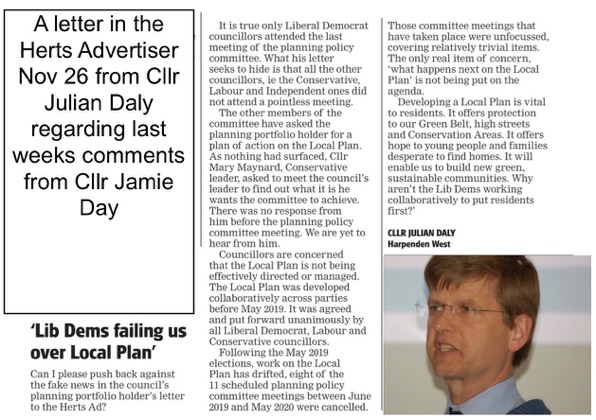CLICK ON THE LINKS BELOW FOR MORE HARPENDEN NEWS
Housing & infrastructure in Harpenden 2021/20
May 25. Shock news. Even more homes could be built by Central Beds on land by Thrales End Lane, following a ‘Call for Sites’.
The Call for Sites was an opportunity for agents, landowners and developers to submit land which they believe could be developed to meet future demand for homes and jobs. The full list of sites that were put forward is now available to view by parish.
Only an estimated 4-6% of the land that has been submitted will need to be allocated to deliver the new homes that are needed.The key land owned by Legal & General is shown on the image below, outlined in orange.
Cen Beds will be holding public events over the summer, where you can find out more about the Local Plan. In addition there will be a consultation on the site assessment criteria from 30 June – 29 July. Once approved, the criteria will be used to shortlist the sites.
Keep in touch for more information.
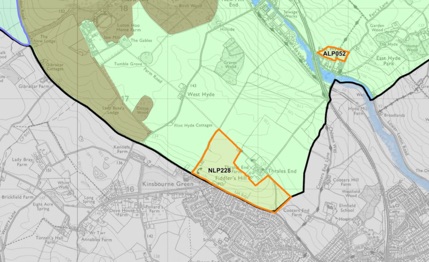
I have just spoken to our head of housing and we do not intend to sell any land. Both St Albans and Central Bedfordshire have called for potential land for housing to be identified and we have submitted numerous sites for consideration. The Central Beds process detailed below confirms that only 4-6% of the land submitted for consideration will be suitable for housing and therefore it is far too early to consider any kind of detailed statement. Local authorities are under a duty to co-operate with each other in any Local Plan process and we expect Central Beds and St Albans to do this. L&G PR DEPT

June 6. Legal & General do not intend to sell any land.
I spoke to the PR dept about the ‘Call for Sites’ information by Cen Beds (see below) Ron Taylor. Editor.
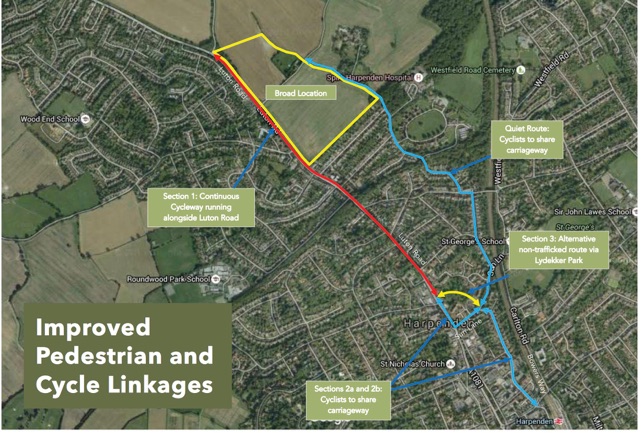
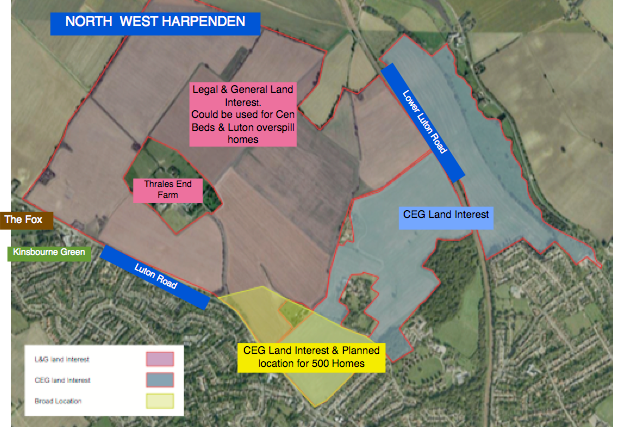
Feb 4. 2018. 1,000 Affordable Homes for Harpenden and Redbourn
Rothamsted Research, working with Lawes Agricultural Trust (LAT), are suggesting the fields to the north east of Redbourn, between the A5183 and Harpenden Lane/Dunstable Road for development as part of the St Albans district council (SADC) new Local Plan (LP).
Who will benefit:
LAT chief executive, Peter Oxley, said: “As one of the largest employers in the area, we are acutely aware of the shortage of affordable housing, not only for our own staff, but also for key workers locally, such as teachers and nurses.”
Director and chief executive of Rothamsted Research, Achim Dobermann said “Income from this development, through the LAT, would allow Rothamsted Research to do more of its strategic research on the future of farming in the UK and worldwide.”
The Redbourn High Street could be revitalised with so many new potential customers just a short walk away.
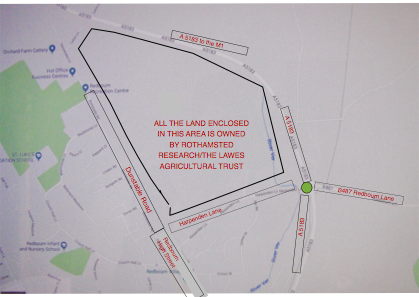
Feb 4. 2018 The right homes in the right places.
Two of the designated sites (A & D) for house building are in north Harpenden, both of which will need considerable supportive infrastructure particularly in road transport improvement.
However there are actually several other sites in other parts of Harpenden that are smaller and in some cases have much better existing road transport facilities. AND they are NOT close to adjacent boundaries of adjoining Councils.
These are the sites that were considered for Harpenden’s new secondary school before site F was agreed.
SO IF THEY WERE SUITABLE FOR SCHOOLS THEY ARE SUITABLE FOR HOUSING. (E.K, I,J,H &G)
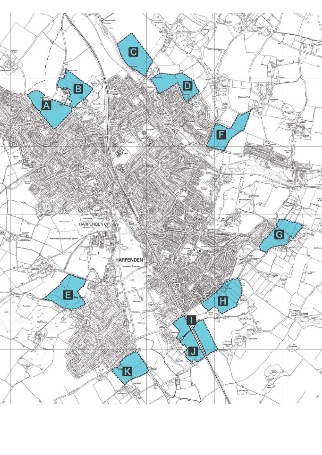
2017 REPORTS
The SLP rejection. What does it mean for you?
The last week has seen a dramatic turn of events which have left the Plan in limbo
whilst SADC Planning and Council Leader Julian Daly try to solve the problem of the Plan’s rejection by the Planning Inspectorate’s David Hogger.
Why the problem?
On Aug 28 David Hogger wrote to SADC saying “I would remind the Council about my
initial pre-hearing concerns regarding the soundness of the SLP”
On Oct 26 a ‘Hearing’ in St Albans presided over by David Hogger heard representations by stakeholders who had major concerns about the details of SADC’s proposals in the SLP. Given the high numbers of negative feed back David Hogger requested written submissions. These were sent to SADC for comment.
On Nov 22 SADC responded to these submissions and effectively refuted all the complaints.
On Nov 28 David Hogger responded to SADC ruling that St Albans District Council’s draft SLP did not meet the requirements of planning law and planning practice saying it had failed to adequately identify, address and seek cooperation on key cross boundary planning issues with adjoining councils such as Dacorum Borough Council and Welwyn Hatfield Borough Council...”it is with regret that I must conclude that the Duty to Co-operate has not been met.” “It does mean that the Council should give detailed and rigorous consideration to strategic cross-boundary matters and priorities and draw robust conclusions with regards to whether or not any of those priorities could be delivered in a sustainable way within the District, bearing in mind the environmental and other
constraints that exist.” And concluding “Any necessary consultation should be undertaken and a revised Plan re-submitted as soon as possible”
IF YOU WOULD LIKE TO READ THE INSPECTORSS LETTER IN FULL CLICK BELOW
Inspectors letter to the Council PDF.pdf
w/e Dec 9 Local Comments
The Herts Advertiser Dec 1:

The Harpenden Green Belt Association E mail Dec 6
“To fall at the first fence in Mr Hogger’s examination is a truly embarrassing setback for your Council. It is anybody’s guess as to what the Council will do next.”
St Albans MP Anne Main
said: “I am very disappointed that the SLP has stalled. This puts the district in a vulnerable position. Without the plan progressing on to the next stage, we can’t know if the housing totals are acceptable. This could have a significant knock-on effect on where is best to build in St Albans.”
She urged: “I hope that the council can move forward rapidly to resolve the outstanding issues to get the plan back on track.”
Redbourn Parish council chairman, Cllr David Mitchell,
said: “The whole thing is an utter mess. The draft SLP may have failed the duty to cooperate issue, but it’s clear the government inspector also has serious doubts about the soundness of the plan.”
Council Leader Julian Daly told the Herts Advertiser
He was not sure what course of action the council would take in response to the inspector’s recommendations. However, he said one option was that developers involved in the SLP consultation might consider taking legal action over the inspector’s conclusions, as their proposed schemes would now face delays as a result. He added: “They could call for a judicial review – it’s a possibility.” Cllr Daly admitted there was a risk that, should the plan ultimately struggle to be formally adopted, the document could be “taken over by the government” for
completion.
What’s the problem with Duty to Co-operate?
Some of the adjoining Councils have large numbers of homes to build and consider that SADC should co-operate with them on where they should be built. It could mean that even more homes than originally planned could be built in our region.
Feb 4. 2018 The view from a local
Developer Jarvis Homes.
Q.1. Would it be preferable to have an approved Local Plan going forward to 2036?
-
A.YES. The current plan was adopted in 1994, the data the policies are based on were put together a few years before, so at the moment decisions are being made on information relevant over 25 years ago, and it is now the oldest plan in the country. Consequently although some of the policies remain relevant many are out of date and do not reflect current policy and thinking. When adopted it was envisaged that the plan would reviewed and updated every 5 years, 10 at most, 24 years later ….
We live in an every changing world and as such there is a desperate need for a plan which maps out the future for the next 20 years and gets regularly reviewed and covers all aspects to achieve sustainable development to accommodate the predicted growth.
Without an up to date plan, the District is suffering as a result of historic out of date policies which are open to challenge, and are not in a position to put the relevant infrastructure in place to accommodate the additional development. In addition they are missing out on S106 contribution, (both financial and affordable housing), as well as CIL payments.
Q.2.Why has it taken so long for SADC to devise a viable plan?
-
A.The inspector will decide whether or not the proposed plan is sound and there will be a lot of debate on this point. Up until recently there hasn’t been any pressure to have a revised plan in place, as government planning policies , particularly protecting the green belt, were being upheld. This lack of pressure and political indecision has resulted in no plan being adopted.
Q.3.Key opponents of the last Strategic Plan (submitted Spring 2017 and rejected) are voicing repeated claims about NOT building on Green Belt; the need assessments for new homes being flawed AND the lack of infrastructure to support new build. Are they being fair?
-
A.Taking the last point first, a sound plan should ensure that there is sufficient infrastructure planned to support the projected growth , if it doesn’t then the plan should be found unsound. To a large extent the question on whether the assessment is flawed or not is irrelevant. The mechanism for calculating the number of homes will come into affect in later this year and hence whether it is right or wrong won’t make a lot difference as it will be what it will be, and we will have to live with the number. Bearing in mind the likely level, circa 915 units per annum, then a substantial number of green belt sites will have to be allocated. As mentioned on numerous occasions it would have been better to be proactive and taking control of the situation , even if unpalatable at the time, rather than saying either no to any development in the green belt or only a few. The other discussion point is where these houses go and whether it should be in a few strategic sites or whether a more holistic approach is required.
Q.4.Government ministers have said that a failure to devise a suitable plan will result in a Government imposed Plan which they would administer. Is this feasible or is it a threat?
A. In theory yes, I suspect that if sufficient progress isn’t made then the government would look to make and example of a Local Authority, but would prefer not to go down this route. From SADC’s perspective would you want to run the risk.



Feb 19. 2018 RESPONSE FROM THE HARPENDEN SOCIETY
Summary
•We accept that the housing stock needs to be increased but we urge SADC to question the basis on which the number of new homes required in the District by 2036 has been calculated because we believe it to be an overestimate
•Harpenden must be fully protected against any negative effects new housing developments may have, particularly in the areas of transport, education and health
•We fully support Harpenden's draft Neighbourhood Plan and seek to ensure that nothing in the District Plan runs counter to its principles
•The District Plan needs to recognise that to address Harpenden's housing imbalance the town's priorities are for affordable housing, small flats, small/medium family homes and homes for those who wish to downsize
•Priority should be given to developments that provide a maximum number of housing units whilst minimising the use of green space
•The character and identity of the town must not be threatened by urban sprawl that would bring closer the threat of coalescence with neighbouring settlements.
Background
We refer to the consultation document dated January 2018 entitled St Albans City and District Local Plan 2020-2036 Have Your Say. The Society, has through its monthly newsletter, encouraged all members to take part in the consultation either on line or by returning the document completed, though this response is the view of the Committee. Clearly we all recognise the background in that the Council has, in the past, been unable to develop and implement the Local Plan and the pressure now being upon the Council to get a new plan through meeting all its obligations and in the knowledge of government strategy to increase housing stock significantly in the south-east of England. So we acknowledge this is not an easy task for you as a Council. The Society wishes to comment at this early stage of consultation though we anticipate there will be further opportunity for residents and community groups to comment as the Local Plan develops.
Querying the Assumptions and Methodology
Already there has been criticism of a number of the assumptions that lie behind the questions in the Consultation Document particularly comments by local members of CPRE and other residents on why the government has arrived at the figure of 40,000 new homes County wide of which the St Albans District figure is said to be 15,000. The point has been made that the latest population growth figures from the Office of National Statistics have reduced their UK population projection by 2 million and that’s prior to any impact of Brexit, particularly in the south-east. Also there has been comment on the very generalised and unspecific nature of some of the questions although we accept that it is very difficult to construct such consultations which give both the public opportunity to comment but in a structured manner.
Comments on the Questions
We wish to reinforce the point about the way the housing demand figure has been calculated. However, we are realistic in knowing that whatever is the finally agreed figure new housing it will mean an increase in housing stock for the St Albans District and for Harpenden. We are anxious that the character of the town is protected and any new housing has the right infrastructure and any negative implications of new development are reduced as much as possible.
This can be achieved by having local planning policies in place that require developers to provide infrastructure and mitigate the impact of their development on the rest of the town. The Committee was impressed by the policies set out in the draft Harpenden Neighbourhood Plan which has been sent to you and for independent examination prior to it going to local referendum later on this year and we will give support. We are anxious that nothing in the Local Plan being developed St Albans district wide runs counter to the realistic and welcome planning policies being suggested in the draft Neighbourhood Plan.
In relation to the specific questions –yes, of course, we wish to see homes built in the right place, for them to be the right kind of homes, for local jobs to be provided, the Green Belt to be protected and our historic buildings, wildlife sites and areas of natural beauty preserved all with an appropriate level of infrastructure. To try and rank these things, however, is almost impossible and becomes a circular exercise. Homes have to be built in the right place and we need an appropriate mix of homes.
The Society has been struck by the argument set out in a letter in the Herts Advertiser on 9 January 2018 by Rick Sanderson which points out that setting a planning framework which allows developers to build in defined areas of a district like St Albans will not achieve any of the objectives set out in your question set on building the right kind of homes. Harpenden is a classic example where the demand for high quality 4/5 bedroom family homes is significant as it enables people often from London to enjoy good schools and a town with a good quality of life all within easy commuting distance of London. Developers make substantial sums for each unit from these developments whilst the margin on the much smaller premises advocated by your questions –affordable housing, first time buyer flats, small/medium sized family homes and homes for those wishing to downsize is far smaller. The sentiments underpinning the questions are all necessary and proper objectives for a community to set in its plan but as the letter so clearly points out they are not achievable by the present set of planning policies as developers will simply not play ball in terms of building the right kind of housing stock in our district. A different approach is needed.
In protecting the character of our communities we feel the policies that are being set out in the Harpenden Neighbourhood Plan are sensible and will go some way to prevent developments that damage our community. Developments need to be structured in such a way that the developer or developers can meet the cost of mitigating damage to our Green Spaces and to our historic buildings, wildlife and areas of natural beauty and as importantly fund the infrastructure required eg schools, doctors, shops, and decent transport and parking.
Consideration needs to be given to denser structures which do not consume so much green space whilst developments that are quite tightly drawn and have the necessary infrastructure can reduce travel, costs of maintenance and can develop a community feel more quickly than sprawling estates and ribbon development. We want to ensure that the openness and character of the land between settlements is maintained in order to prevent adjacent settlements from merging into one enormous conurbation, which would totally change the character of the town and threaten its identity. Harpenden is particularly vulnerable where its northern boundary meets the south Luton boundary; not only is this a county boundary, Luton is under pressure to build a great many more homes and at any time may seek to build right up to its southern boundary.
Intention to Comment further
These are our initial comments but as stated earlier we will wish to comment in some detail as the Plan is developed.
Philip Waters
Chair, on behalf of the Harpenden Society Committee
19 February 2018.
FEB 9. COMMENTS FROM THE HARPENDEN GREEN BELT ASSOCIATION
They are focussing on the issues raised in the SADC ‘HAVE YOUR SAY’ questionnaire. These comments are taken from the HGBA Jan 18 Newsletter which can be read in full on their web site.
‘Large-scale development on Green Belt generates the money and land that provides new infrastructure like roads, schools, shops and parks’ is breath-taking in its simplicity. Developers have never been known for their bountiful generosity and they have no role in funding our existing chronic infrastructural needs.
Central government funding and Hertfordshire County Council funding can no longer be counted on for planning purposes because the public purse has been cut and cut again.
There’s a question on infrastructure which asks us all to rate the kinds of infrastructure we need as more or less important. But don’t we need all of these types of infrastructure, to support both new and existing residents? Why should we be asked whether it is more important to have schools or GP facilities – don’t we need both?
For those of you who want to sample the flaws in the planning system which will impact all of us, you can read a short and recent article by Rick Sanderson who is experienced in local planning matters. See the link in the newsletter. In his first paragraph, he says ‘we are being forced into planning for far more houses than are actually needed in the vain hope that the housing market will provide these dwellings and that house prices will come down’
HGBA has repeatedly made clear that we consider that there are serious flaws in the Green Belt Review. We will be telling SADC that ‘the way we feel about this approach to identifying potential land for building in the Green Belt’ is very unhappy indeed
Note that building on the eight Green Belt sites that SADC has depicted on the back of its questionnaire will not meet the housing targets. Building on these sites would mean 500 homes at ‘North West Harpenden’ and 770 at ‘North East Harpenden’, in addition to the new homes which SADC will build within the town.
The questionnaire says that SADC wishes to provide accommodation of the type that local people need. In the case of Harpenden, buyers from London who are selling up in London, can outbid local people and are doing so. For developers, this is a dream situation. They have the excuse of more and more building ‘for local people’ but, it will not be local people who are the majority of buyers.
http://www.harpendengreenbelt.org.uk

Feb 13. How Redbourn Parish Council have responded to The Local Plan Questionnaire...‘Have Your Say’
FEB 20.Hertfordshire County Council offers Radlett airfield site for new homes as part of The Local Plan.
David Williams, Leader of Hertfordshire County Council, said: “We’ve always said that we’d prefer the Radlett airfield site to remain as Green Belt and that we’d rather not sell it, but we recognise that we need to build 90,000 new homes in the county over the next 15 years and some 13,700 of those will need to be in the St Albans district.
“That’s why it makes sense for us to offer up this land, which we own, as a possible site for a Garden Village with 2,000 new homes and the infrastructure to support them. We know that developers are interested in this idea and we feel it could be an alternative to using the land for a Strategic Rail Freight Interchange.”
“Along with the other land we’re putting forward, this will make a significant contribution towards providing the new homes that our county will need to support a growing population and an increase in local jobs.”
Feb 9. Views on The Local Plan from a Harpendia reader.
Most people who would like to live in Harpenden can't because our houses cost too much to buy or to rent and building more large houses will not lower their price because there is an endless stream of people coming from London who can afford them; in order to make cheaper housing available in Harpenden small homes must now be built
Homes should be built close to where people work; relatively few people who live in Harpenden's larger family homes work in the town (they commute to London), so the argument for building more such homes is weak
There are jobs for low-paid but key workers in Harpenden (in education, health, retail, catering, transport, construction etc.) but few homes they can afford to buy or rent; providing such homes must therefore be a priority
The high divorce rate has increased demand for smaller, single adult occupancy homes; this has further increased the demand for smaller housing units.
A public consultation on a new draft Local Plan (LP) that identifies land for new housing, commercial building and infrastructure development in the St Albans District inc Harpenden will run from Tuesday 4 September and runs for just over six weeks until
Wednesday 17 October.
People can have their say online at www.stalbans.gov.uk/LocalPlan2018. The website page has a video that explains the major issues involved.
The draft LP covers the years 2020 to 2036 and conforms to a Government proposal that 913 new homes a year – 14,608 in total – should be built during that period.
Eleven sites in the Green Belt to provide some of the new homes and jobs have been put forward.
Councillor Mary Maynard, (pictured) Portfolio Holder for Planning, said:
“I believe we have produced an LP that balances the need to protect the Green Belt as far as we can while allowing for the creation of much-needed news homes, employment centres and infrastructure. “It is important that we hear from as wide a cross-section of the public as possible so that all voices are heard.”
After the consultation closes, the Council will consider the feedback and decide if any changes are required.
If all goes to schedule, the LP will then be submitted in March to the Secretary of State for Housing, Communities and Local Government who will appoint a Planning Inspector to examine it.
Information about the LP is also available at the Council’s offices at the Civic Centre, St Peter’s Street, St Albans, as well as public libraries and Town and Parish Council offices.
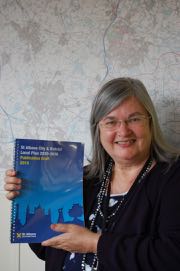


DETAILS ABOUT THE NEW LOCAL PLAN and how it affects Harpenden presented by Cllr Mary Maynard at The Harpenden Society public meeting on Oct 2. 2018
Photo L2R. Geoff Newman, Cllr Mary Maynard, Philip Waters
The key issues being:
*The Plan has to be approved by the Planning Inspector in 2019.
*If it fails the Government will step in and operate a Plan themselves or ask a neighbouring Council to do so.
*All developments have to utilise land from the ‘Call for Sites’
*A strict process has to be followed to authorise the most suitable sites for development
*The Plan has to follow Government instructions on the number of homes to be built in the time frame 2020/2036
*Adjoining Local Councils have to be consulted.
THE GRAPHIC BELOW SHOWS WHERE THE 2 LARGE HOUSING DEVELOPMENTS ARE GOING TO TAKE PLACE.
In the case of North West Harpenden the first 75 homes of 580 will be built in 2022/2023
and a further 75 each year till 2028/2029
and the last 55 in 2029/2030
In the case of North East Harpenden the first 75 homes of 760 will be built in 2026/2027
and a further 75 each year until 2035/2036
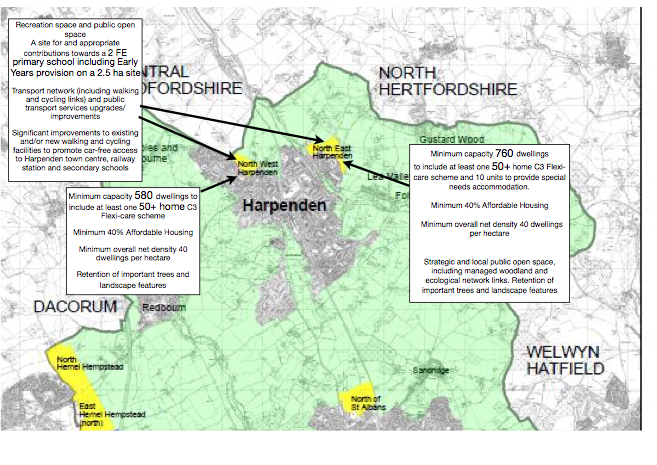

More details to follow when the draft plan has been further analysed. Below; Mary Maynard presenting details to the audience on Oct 2.
Oct 4. A comment from a Harpenden Society member following the presentation:
I have lived in Harpenden since 1964 and the population has grown from ,I think, 22,000 to 32,000 so expansion is nothing new – Trying to remember now,I made my remarks accepting all the facts that we were given last night are correct – It is a difficult situation almost insolvable if it is to meet all the demands of the residents - The people of Harpenden cannot be complacent – The plan has not been updated since 1999 and appears to be the final offer – If we do not accept it ,or if we do not finalise it I understand the Government will take over and do it for us – That would be a disaster – The people of Harpenden must take responsibility themselves for this plan – On the traffic front they must understand the traffic situation and not expect to be able to pop out any time they like and park in front of Waitrose or Sainsburys whilst they shop – It always puzzles me when people sit in their cars and complain about the heavy traffic they are helping to create! – People will just not use the local buses – The one from Southdown has been cut to almost nothing due to lack of use and I understand that the “exciting” new development of the route from Roundwood has not been successful – This despite the fact that most of us have a free bus pass - I cannot see how a park and ride can be a success when a large proportion of the shoppers are well past retirement stage and unable to walk any distance – The “affordable” houses will probably never be built unless the Planning Authorities have a law to back them up – Regarding Social housing , how will they identify “needy people from Harpenden only” ?- What is to stop people moving into Harpenden with a short term rent to claim they are “Harpenden people” – I had a chat to a few people at the end – They believe that it will never happen and the Government will never take things over – One of the veterans claims that there is no demand in Harpenden for Social or affordable housing and people move to Harpenden to buy 4 or 5 bedroom houses only – It is all a very unclear pickle! –
Oct 18. 2018. Serious flaws in the Local Plan highlighted by The Harpenden Green Belt Association:
Legal Issues. Soundness.
Duty to Co-Operate
Green Belt Boundary Changes/Strategic Sites
Absence of Transport Evidence Base
Lack of Proper Infrastructure Planning
Read the full document, now submitted to SADC, by clicking on this link.
http://www.harpendengreenbelt.org.uk/HGBA%20Regulation%2019%20consultation%202018.pdf

Sept. A Freight Terminal in
Radlett or thousands of new
homes? St Albans M.P.
Daisy Cooper wastes
opportunity to make a
solid case to oppose the
Terminal in Parliament.
St Albans M.P. Daisy Cooper made a statement to Parliament on Tuesday 1st September which attempted to oppose the Railfreight site. It quickly became apparent that she had been badly briefed by her Liberal Democrat Councillor colleagues who run St Albans and District Council and who made the decision to support the Railfreight site in the Local Plan Inspection.
Daisy repeated a number of inaccuracies about the Local Plan and the rail freight interchange, which negatively impacted her case.
For example, she stated that "the Local Plan was suspended by government inspectors. Christopher Pincher M.P. (Housing Communities and Local Government Minister) pointed out that there are no government inspectors and that the Planning Inspectorate are independent professional planning experts not employed by the government."
She further stated that, "The Inspectors have told the Lib Dem administration at SADC that unless they withdrew housing from the local plan for the old Radlett aerodrome that they will lose their ability to build any houses at all."
Nowhere in any correspondence to SADC does it state this. The Inspectors asked a series of technical questions about the site, they did not ask for housing to be removed. Removing housing, thus giving the go ahead for a Railfreight site was a political decision made by a Liberal Democrat Portfolio Holder. Moreover, any planning application brought before the council must be considered and is judged on its merits.
It was also disappointing to see that not one Lib Dem or opposition M.P. saw fit to support Daisy as she sat totally on her own on the opposition benches.
Given these inaccuracies, local Conservatives have already offered to work with Mrs Cooper on the rail freight issue to stop the current Council administration’s support for Railfreight and to ensure she is properly and accurately briefed.

Sept 7. 2020. Flexible rail ticket options needed for Harpenden commuters returning to work in London.
Harpenden M.P. Bim Afolami suggests 3 day season tickets to Grant Shapps, the Government Secretary of State for Transport.




<!-- Default Statcounter code for HARPENDIA
<script type="text/javascript">
var sc_project=5738164;
var sc_invisible=1;
var sc_security="6239dc64";
</script>
<script type="text/javascript"
src="https://www.statcounter.com/counter/counter.js"
async></script>
<noscript><div class"statcounter"><a title="Web Analytics"
href="https://statcounter.com/" target="_blank"><img
class="statcounter"
src="https://c.statcounter.com/5738164/0/6239dc64/1/"
alt="Web Analytics"></a></div></noscript>
<!-- End of Statcounter Code -->
<!-- Default Statcounter code for HARPENDIA
<script type="text/javascript">
var sc_project=5738164;
var sc_invisible=1;
var sc_security="6239dc64";
</script>
<script type="text/javascript"
src="https://www.statcounter.com/counter/counter.js"
async></script>
<noscript><div class="statcounter"><a title="free hit
counter" href="https://statcounter.com/"
target="_blank"><img class="statcounter"
src="https://c.statcounter.com/5738164/0/6239dc64/1/"
alt="free hit counter"></a></div></noscript>
<!-- End of Statcounter Code -->
Nov 24. 2020.
The latest Local Plan (rejected by Inspectors on
July 2) has been completely withdrawn by SADC.
They have decided to start again and reassess
the fundamental proposition of more housing for
the whole district including Harpenden up to 2036.
THIS INCLUDES THE LEGAL & GENERAL
DEVELOPMENT IN NORTH WEST HARPENDEN.
As presented to residents back in early 2020.
NOW CANCELLED
Almost a year ago the Government under Theresa May warned Councils that failure to present a viable new Plan would result in Government taking control. We now have a new Boris led Government which has recently had its Housing proposals pressured off the agenda by many Tory MP’s. Brexit finally implemented in January, and Covid-19 still to be contained.
So now SADC will be spending even more of Council Tax payers money to devise a new way ahead.
Here is what they are saying:
St Albans City and District Council will now start afresh on a new LP that will focus more on climate change and sustainability.
A decision to withdraw the draft was made by the Council’s Cabinet at its meeting on Thursday 19 November.
It followed issues raised by Government-appointed Planning Inspectors about some of the content and the way it was prepared.
An LP earmarks land for future housing and commercial building as well as the infrastructure to support new developments.
The Council is committed to producing another draft for the years to 2036 to help provide new housing and grow the local economy.
There will be extensive consultations with neighbouring Councils, landowners, developers, residents and other groups.
The draft that emerges will then have to be approved by Full Council and submitted to the Government for an examination before it is adopted.
A timetable for work on the new draft will be given to a meeting of the Council’s Planning Policy Committee next month.
Councillor Jamie Day, Portfolio Holder for Planning, said: “We felt we had little choice but to withdraw the draft given the disappointing response of the Planning Inspectors.
“By starting anew, we have an opportunity to better address issues which have become ever more pressing since the withdrawn draft was composed.
“These include the need to recognise the impact of climate change and the need to ensure any new developments will meet strong sustainability standards.
“We also have to bear in mind that the Government has proposed major changes to the planning system and that may alter the whole Local Plan system.
“However, that is some way off, so we will carry on with the challenge of creating a new LP under the current rules and look to see if we can gain some cross-party support for this difficult but highly important endeavour.”
Councillor contact:
Councillor Jamie Day, Portfolio Holder for Planning for St Albans City and District Council: cllr.j.day@stalbans.gov.uk.

